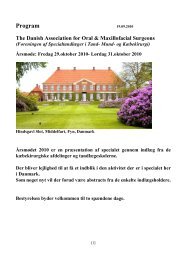FSTMK Annual Meeting 2011 - Foreningen af Specialtandlæger i ...
FSTMK Annual Meeting 2011 - Foreningen af Specialtandlæger i ...
FSTMK Annual Meeting 2011 - Foreningen af Specialtandlæger i ...
Create successful ePaper yourself
Turn your PDF publications into a flip-book with our unique Google optimized e-Paper software.
Background: Treatment of tooth loss with osseointegrated oral implants has a high success rate.<br />
However, placement of implants is frequently comprised or impossible due to atrophy of the alveolar<br />
process. Autogenous bone is generally the preferred gr<strong>af</strong>t material for reconstruction of the alveolar<br />
process and is usually harvested from the mandibular ramus. However the use of autogenous bone<br />
gr<strong>af</strong>ts is associated with the risk of donor site morbidity and complications.<br />
Purpose: The aim of the present study was to evaluate the morbidity and complications <strong>af</strong>ter bone<br />
harvesting from the mandibular ramus.<br />
Material and methods: 374 surgical procedures performed at The Department of Oral and Maxillofacial<br />
Surgery in Aalborg from the year 2000 to 2010 were retrospectively analysed based on records and Xrays.<br />
Data from records and X-rays was conducted according to registration sheet.<br />
Results: The frequency of temporary change in sensitivity was 5,9 % (n=22). The frequency of<br />
permanent reduced sensitivity was 0,5% (n=2). Hematoma occurred in 20 cases. Infection was<br />
registered in one case.<br />
Conclusion: The results of this study showed that bone harvested from the mandibular ramus is a s<strong>af</strong>e<br />
surgical procedure with few complications.<br />
Kristian Thesbjerg, resident<br />
Dept. of Maxillofacial Surgery, Aalborg Hospital, Denmark<br />
Abstract<br />
Deviation <strong>af</strong> næseseptum ved SARME<br />
Formål: At undersøge om løsning <strong>af</strong> næseseptum i forbindelse med SARME operationer har betydning<br />
for postoperativ deviation <strong>af</strong> næseseptum.<br />
Materiale og metode: I alt 20 patienter indgik i undersøgelsen (M=9, F=11) Patienterne blev vilkårligt<br />
grupperet i to grupper. Gruppe I (n=10) med løsning <strong>af</strong> næseseptum og gruppe II (n=10) uden løsning <strong>af</strong><br />
næseseptum. På alle patienterne blev der foretaget CBCT optagelser umiddelbart før<br />
distraktionsprocessen og ved <strong>af</strong>sluttet distraktion. Opmåling blev foretaget i Dolphin Imaging 11.0.<br />
Målemetoden blev testet ved at opmåle samme 10 patienter 2 gange med en uges mellemrum.<br />
Resultater: Gruppe I: 4 patienter viste en deviation på > 1,5 mm. efter distraktion. Gruppe II 1 patient<br />
havde deviation på > 1,5mm. Metode studie viste en maximalt SD på 0,46 mm og et konfidensniveau<br />
95 % på maximalt 0,33 mm.<br />
Diskussion/konklusion: Nærværende undersøgelse viser at løsning <strong>af</strong> næseseptum er nødvendig i<br />
forbindelse med SARME. Imidlertid er den kliniske betydning for den øgede risiko for deviation <strong>af</strong><br />
næseseptum stadig uklar, men formentlig uden betydning. Der er med baggrund heri grundlag for<br />
yderligere undersøgelse, involverende en klinisk vurdering <strong>af</strong> næseseptum<br />
[11]



